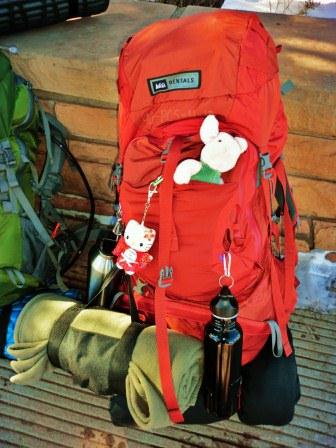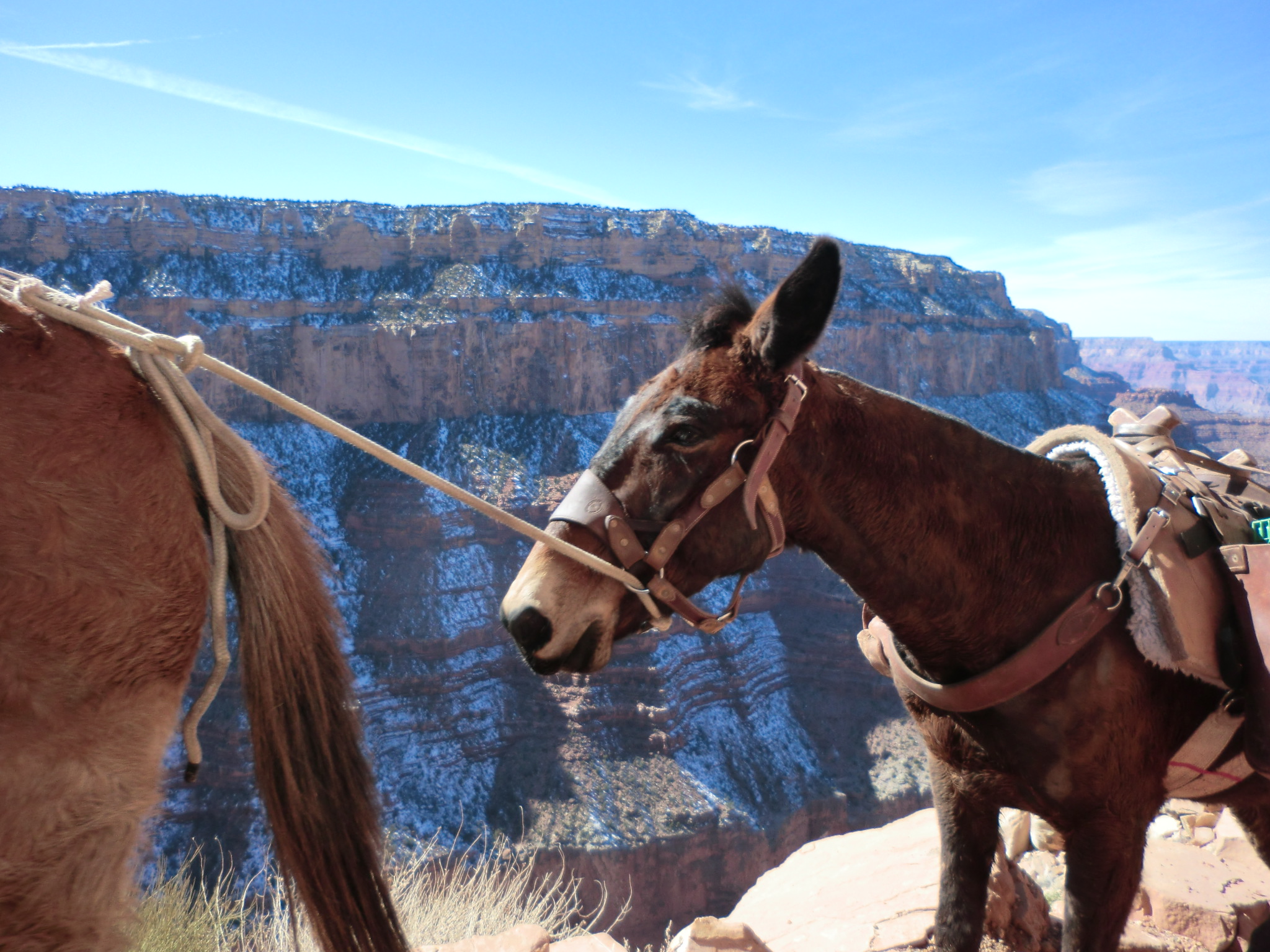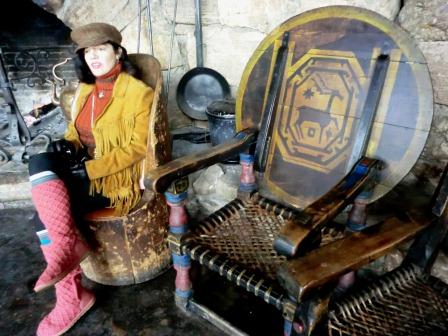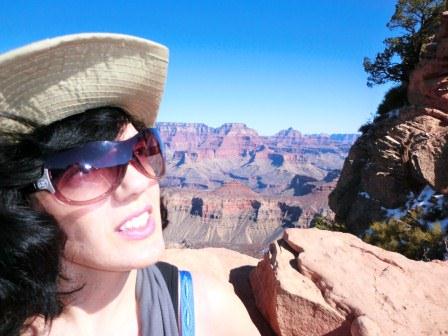For those whom recall my original Grand Canyon challenge to Sugar Belle, as well as my brief follow-up post, please enjoy the following, full-length narrative, on the one-year recollection of a most wonderful trek to the depths of the Canyon (and a surprising, Jennifer Aniston sighting) and, naturally, back to the Rim where a much needed, heartily-earned, hour-long, lemongrass shower and subsequent martini awaited.
The dining hall is virtually empty, with the exception of our small crew and Jude, a kind, slightly bohemian fellow working the Phantom Ranch Canteen. On this ghostly quiet, February afternoon, the Ranch is appropriately named. As there are no other guests to tend, Jude chats with us and asks our story; we return the curiosity, and wonder about his story, working at the very bottom of the Grand Canyon. He brings us some of the best beer any of us will ever imbibe, given its Tao-like actualization, and tells us.
ghostly quiet, February afternoon, the Ranch is appropriately named. As there are no other guests to tend, Jude chats with us and asks our story; we return the curiosity, and wonder about his story, working at the very bottom of the Grand Canyon. He brings us some of the best beer any of us will ever imbibe, given its Tao-like actualization, and tells us.
"Working below the Rim is like nothing else, anywhere," Jude claims with a smile that upholds the claim. Even though he hikes in and out on his own time, and his own dime, it's a nature-gig, similar to being a lifeguard or snowboard instructor, well worth the physical effort and light pay. For the mellow dude from Phoenix, just getting to be in the Canyon is enough. It may seem simple, working in a restaurant at a national park, but it's not simple by a long shot. In fact, it's phenomenal when one realizes that, of all the humans of the planet, only a small, anthropologically-insignificant handful has actually sipped where we did that day.
Eight-hundred years after Havasupai tribes slept in pit houses at the Canyon's lowest point, and well over one-hundred years before Jude regaled us with tales and ales, John Wesley Powell, a grandfather of 19thCentury American West conservation, camped along the waters of what is today Phantom Ranch and Bright Angel Campground. In 1913 Teddy Roosevelt made his way to this same spot via mule and slept in the same camp where the Havasupai, J.W. Powell and our little group all slept. Today, it is difficult to imagine there hasn't always been this oasis of running water, summertime ranger talks, pampered mules and all the seven-dollar postcards, vegetarian chili and four-dollar cans of beer your heart desires.
Near the turn of the 20thCentury, in a time noted by Lesley Poling-Kempes in her book The Harvey Girls: Women Who Opened The West, there were "no ladies west of Dodge City and no women west of Albuquerque". Architect and noted interior designer Mary E.J. Colter was the exception to this sentiment.
Colter worked under the umbrella of hospitality-pioneer Fred Harvey and the Santa Fe Railway, designing a multitude of hotels, train stations and tourist destinations running alongside the railway's Midwest and Southwest routes. The Grand Canyon was socially and financially vital for both the hotelier from London and the Santa Fe Railway. Scores of the prettily-starched, well-mannered, butler-schooled Harvey Girls would make the Canyon their home for months at a time, bringing not only a touch of glamour and finesse to the rugged West, but tourism dollars and word-of-mouth still seen today.
The queen of the Harvey Girls was Colter herself and, in addition to the El Tovar Hotel, Hopi House, Lookout Studio, Hermit’s Rest and the Indian Watchtower, she was commissioned to create cozy lodging on the ancient Canyon floor. Her task was to "fashion a place of food, lodging and comfort against an austere backdrop". Incorporating local materials, the most logical choice, and influenced by local Native American motifs, her signature, architectural style would come to be known as National Park Rustic: a phrasing that immediately evokes Old West comfort and natural relaxation.
Nearly a century later, I sit in one of Colter's many commissions: the Phantom Ranch Canteen. Had we booked earlier, we might have enjoyed one of her small yet comfy cabins. No worries, though. The Canteen is all the indoors we desire this trip. Camping under the stars, on the Canyon floor is an experience not to be underestimated. Who knew there could be so many stars?
To attain this reward, the stars and bar at the bottom of the Canyon, is no simple journey. A 7.3-mile hike of 5,000 vertical feet is physically, psychologically and spiritually demanding. Of course, as with any journey, it all begins with the first step; and that first step better be in good shoes. Under the care of my Ralph Lauren hiking shoes, my feet emerged pretty happy from the Canyon after a total of six days and nearly eighteen miles over rocky, muddy, snowy, steep terrain.
Once the soles are we ll-protected, one must prepare the soul, best as one can. This is where a naturally cheerful spirit comes in handy. If you're inclined to grouse about the little things in life, the task of hiking the canyon might not fit your temperament. Then again, you might need the Canyon more than most.
ll-protected, one must prepare the soul, best as one can. This is where a naturally cheerful spirit comes in handy. If you're inclined to grouse about the little things in life, the task of hiking the canyon might not fit your temperament. Then again, you might need the Canyon more than most.
Words like magnificent, breathtaking, awesome, surreal and inspiring are bandied about ad nauseam in description of the Grand Canyon, and with good reason. Be warned, even the mightiest of men are brought to a quiver when sitting atop Ooh Ahh Point and peering to the depths below, or viewing the Colorado River for the first time from a switchback on the Kaibab Trail. Being February, the trail transitions without warning, from crunchy snow to gooey mud to dusty clay and back again. If your toes, thighs and lower back can handle a full day of forward pitch and decline, you will be rewarded by nightfall.
Along the way, the legendary Grand Canyon mules are a very special reward. You will bump into the dark-eyed darlings on occasion, maybe even literally if you're laughing with your pal and not paying attention and don’t hear the lead wrangler call out, Mules. Mules. Mules! As chill as Woody Harrelson sitting on a beach in Cabo and sipping a Dos Equis, these grade-A mules do not spook easily. If you're an animal lover, be prepared to squeal each time you see one and earn yourself an eye-roll or two from a wrangler, but not a startle or a peep from the mules. They react to seemingly nothing, move at their own pace and at their own, oft stubborn will. There's plenty of room to hug a cliff as they pass, but keep in mind and watch your behind, the mules only travel one way: up the South Kaibab, down the Bright Angel. Don't get caught getting goosed by a mule.
If you're lucky, as the mules pass, one might pause and nudge you with his muzzle. You'll freeze, afraid of what to do and certain you'll be the cause of the Canyon's next environmental tragedy. Fret not. The wrangler will simply, curtly instruct, "Pet him. He wants a pet." Do so and he'll be on his way. If you're extra lucky, one of those wranglers will be a dead ringer for Jennifer Aniston and you'll do a double-take, wondering, "So this what she does between gigs?" Sadly, by the time you think all this, she's already around a switchback and you can't tell for sure. You'll never be sure and think what a great rumor to start, about her being a mule wrangler at the Grand Canyon.

As the day wanes and the mules and Jennifer Aniston have long passed you by, it becomes necessary to start the mind games and get yourself to your campground. You still have a few miles to go, dark is setting in, the trail is thin of fellow travelers and you're beginning to wonder what it would be like if you had not checked out of the Bright Angel Lodge this morning. You'd still have that great Rim view, but you'd be eating spinach enchiladas and sipping green tea at the restaurant right now, and looking forward to sleeping in your little cabin, in the bed. Like the mules, however, you must trudge forth. As one in our group said, "I'm just walking on the ground. That's what I'm doing today, walking." So we are.
Focus. One foot in front of the other. Focus. Correct walking stick placement, forming a three-point stance on the ground at all times. Think of Gen. George Washington and French Commander Rochambeau. They marched their troops from New York to Virginia 1781. White Plains to Yorktown in shoes of the wrong size, shoes of no size or maybe even no shoes at all, just pieces of leather and cotton tied loosely with rope to the bottom of bare feet. If they could do that, I can do this. Think about the Havasupai walking this trail in bare feet altogether, in the height of summer no less and without any REI water packs. Think of the Trader Joe's Block Red Shiraz at the bottom of your backpack: a box of wine equal to four bottles! (Ah, yes, that's stirring something!) Think of the Starbucks Via packets in your backpack, which will bring your everyday cup of morning brew new meaning when sipping it alongside Bright Angel Creek at sunrise. (Yes, yes! It's working!)
Toward the end of the South Kaibab Trail, just when we were feeling pretty chipper and excited about campground wine and the resting of the bones, the last two miles set in and did their best to break our spirits. This was no longer a walking path; this was a jumping path. Do not let the last two miles win.
Do not think of your knees or your bruised toenails as each jolting, nine-inch step down the final mile, wood-railed steps dug into the trail for the mules, makes you want to toss every piece of hardware you're carrying directly over the next ledge. Do not think about the mountain goat eyeballing you. Do not think about the mountain goat now trotting down the slope directly toward you. Do not think. Run! Do not turn your back on him. Step away from the ledge. Brace yourself! Phew, he turned. He just wanted a different view. So do I. Think about the wine, the coffee, Washington, the Havasupai, the mules and what Jennifer Aniston's next gig might be and eventually, you shall arrive. You have to. There is nowhere else to go.
 Think about the silence, the river, the ravens, the deer, the glorious lack of electronic media and the fact that you are one of a mere handful of bipeds fortunate enough to ever experience the pit of the Grand Canyon, a hole on the Earth, half the age of the Earth itself. Think on that, not the screaming pain in the balls of your feet. Also, if you're afraid of heights, do not think about the Kaibab Suspension Bridge coming up, swaying some 65 feet above the Colorado River, depending on the river's changing level. You have to cross the river somehow; this is the only way tonight.
Think about the silence, the river, the ravens, the deer, the glorious lack of electronic media and the fact that you are one of a mere handful of bipeds fortunate enough to ever experience the pit of the Grand Canyon, a hole on the Earth, half the age of the Earth itself. Think on that, not the screaming pain in the balls of your feet. Also, if you're afraid of heights, do not think about the Kaibab Suspension Bridge coming up, swaying some 65 feet above the Colorado River, depending on the river's changing level. You have to cross the river somehow; this is the only way tonight.
Finally stumbling in on nothing but thankfulness to be alive, we reached Bright Angel Campground well after dark. The downside to arriving at a campground at night is this; it is dark. One cannot see anything, least of all the best site to choose. We blindly fumbled down the campground path until we found an open spot and threw down our packs like they had fleas. Despite trail promises, we were too tired to savor our wine. Granted, it was a wonderful treat, but merely a tasty sleep elixir. By morning though, the sunrise cup of Starbucks Via Italian Roast kept its trail promise to be simply astounding.
After coffee however, we saw the crucial error of our late-night ways. We chose a campsite decidedly not on the creek. Powered by Starbucks and moving like the law was coming for us, we hauled our tents and gear to an open site directly on Bright Angel Creek. It might not seem much difference, those few yards, but it is indeed a world of difference. It is like living at the beach, just across the road from the sand; it's Heavenly, but there's still a row of houses across that road, directly on the sand. That's where you really want to be, but who can afford the taxes?
Once the camp was reestablished, it was time: Phantom Ranch Canteen-time. The canteen is a short walk through the ranch, including a stop on a small bridge to check for fish in the creek and another stop to read a National Register of Historic Places plaque: Trans-Canyon Telephone Line Built in 1935. If anyone deserved a cold can of beer, it was those early Mountain Bell workers. Of course, since they weren't there, we were the next most-deserving.
Grand Canyon Brewery White Water Wheat was the brew of the day. True, my inclination tends toward Guinness and, as a rule, do not generally drink anything from can. Had I known it was an option, I would have preferred the Brewery's Starry Night Stout. Still, at this moment, the light wheat ale is pure perfection. Elsewhere in the canteen sit shelves of board games, Dominoes and cards, waiting patiently for the analog gamer; shelves of books, for purchasing or borrowing, also lie in wait. Even a surprisingly well-stocked sewing kit, in an old, Danish cookie tin, rests dusty and unused on a lower shelf. This proved helpful after purchasing a Phantom Ranch patch, available only at the Canteen. That night, by headlamp-light in my tent, I sewed it onto my ritual, camping, Boy Scouts shirt.
Even better entertainment than an old chess board is the complete lack of entertainment. There are no televisions in the Canteen. There is no electronic gaming. There are no smartphones, laptops or tablets below the Rim; at least there's no use for them. Signals are few to none and batteries die instantly, as if there's a ghost nearby feeding on your power supply. Sure, you could try to check the weather on your device, but it won't change your plans. You could try to check the news, but you don't care. You could try to check your email, but why did you come here in the first place?
I made the grave mistake of bringing a Kindle, thinking I would read loads of Mark Twain. Nope. By the time I plopped onto my sleeping bag at night, I had just enough energy to flip through my analog, Simpsons comic books. Thank goodness for pack-out mule service available at the Canteen. My pink Kindle and twenty-eight more pounds of poorly-planned, unnecessary gear gathered from amongst our crew made its way back up the canyon walls, via mule, and waited for us topside across from Bright Angel Lodge at the Grand Canyon National Park Mule Barn.
Looming over our ground-floor serenity, is the niggling realization that we still have to get out of here somehow. Because it's nearly ten miles and 4,500ft up and out, egress is best broken into two days, with an overnight at Indian Gardens. Thinking the first day would be the easier of the two proved wrong. Though it was just under five miles, it was primarily steep, punishing switchbacks. Moreover, on this rare February day, it was bright, sunny and hot. The overnight respite at Indian Gardens proffered little help. Cold and uncomfortable, it was nothing like Bright Angel: no trickling creek, no deer sipping in the streams, no ravens conversing in the trees and certainly no canteen. Indian Gardens is just a place to hang your pack, some hard dirt to sleep upon and fresh water to get you going in the morning. Worse yet, the Rim overhangs your campsite and mocks your every nighttime movement and effort to sleep, reminding you of what awaits you tomorrow.
 Happily, the second day out was almost as exhilarating as the day at the Canteen. Marked by two rest houses (1.5-mile and 3-mile), the last leg is nicely split up into psychologically manageable treks. To boot, because it is a common day hike from the South Rim there are far more hikers on the road, offering safety-in-numbers peace-of-mind. Further, knowing we would not only survive, but that hot showers with lemongrass body wash awaited us at the Kachina Lodge and martinis at the El Tovar, we kicked up our paces like a herd of horses headed back to the stables. It is also the day Jennifer Aniston smiled at me, atop her clippy-cloppy mule along the trail, which is apparently what she does in between gigs.
Happily, the second day out was almost as exhilarating as the day at the Canteen. Marked by two rest houses (1.5-mile and 3-mile), the last leg is nicely split up into psychologically manageable treks. To boot, because it is a common day hike from the South Rim there are far more hikers on the road, offering safety-in-numbers peace-of-mind. Further, knowing we would not only survive, but that hot showers with lemongrass body wash awaited us at the Kachina Lodge and martinis at the El Tovar, we kicked up our paces like a herd of horses headed back to the stables. It is also the day Jennifer Aniston smiled at me, atop her clippy-cloppy mule along the trail, which is apparently what she does in between gigs.
Eventually, we made that final mile, which is steep, brutal and exhausting. Shuffling past friendly Austrian and Japanese tourists at the trailhead, we crossed under the final arch at the South Rim and reached Kolb Studio: former home, studio and business of adventure-photography pioneers and brothers, Emery and Ellsworth. It's a Grand Canyon fixture since 1904 and today serves as a gallery and bookstore. It also serves as a world-famous, scenic lookout, perched precariously on the Rim and with a mind-blowing backdrop. Needless to say, the path at this point is clustered with cameras.
We politely squeezed past large groups of large tourists getting their pictures taken and, once past them, crossed into The Village: a shopping and dining compound encompassed by the park hotels and bordered by the Rim itself. In an instant, we are surrounded by more humans than we have seen in a week. Our noodle-legged shuffles morph into strong struts. There are not suitable words to describe the pride of accomplishment, walking through The Village at that moment amidst the day-trippers, shoppers and shutterbugs. With the satisfied look of the overconfident, unwashed, underfed and freshly-spewed from the mouth of the Earth, we march toward our rooms, showers and, eventually, El Tovar martinis.
Before heading into the lodge, we stand at the Rim for one last look, that day anyway. Walking sticks in hand, 35lb-packs now seemingly weightless, we silently take it all in together. Being part-human, a few stinging tears tried to breach. Being in public, I fought them down successfully. In the truest sense of the word, it is stunning. If I just did that, if I just went down there and clawed my way back up, I can do anything. Really.
At the turn of the 20thC., the Harvey Girls were already legends in their own time. Floating effortlessly and elegantly through the Grand Canyon hotels and restaurants, their stark-white aprons, headbands and bows starched to perfection, the Harvey Girls greeted and cared for guests, top to bottom. That included the bottom of the Canyon. With their fresh smiles, brightly rested eyes and manicured nails, even Phantom Ranch was a respite of rustic luxury amidst the harsh elements. Today, sadly, the Harvey Girls are no more and travel reviews will offer the spectrum of great-to-rude Xanterra service experiences. For our part, Jude was our Harvey Girl of the Phantom Ranch Canteen.
Jude the kindly bohemian lacked only the starched apron. His manner was professional yet affable, like Mark Twain filling in for a friend working Morton's Steakhouse. He could sense when we wanted a ripping good yarn and when we wished to be left to ourselves. The fare was first-rate, with prices to match and beer was cold, which is just what one wants, even in February. Overall, the experience was exactly what one wants on the way to Middle Earth.

In 1903, U.S. President Teddy Roosevelt stood at the Rim and grandly stated the following:
I hope you will not have a building of any kind, not a summer cottage, a hotel, or anything else, to mar the wonderful grandeur, the sublimity, the great loneliness and beauty of the canyon. Leave it as it is. You cannot improve on it. The ages have been at work on it, and man can only mar it.
There are a number of buildings now, a lot of summer cottages, a few hotels and more. To boot, I am pretty certain, Jennifer Aniston is an off-season mule wrangler. I wonder what T.R. might think? In the end, I wish I could sum up my winter expedition better than Lawrence Kasdan in his 1991 film Grand Canyon. I cannot. So, I charge Simon (Danny Glover) to do it for me:
When you sit on the edge of that thing, you realize what a joke we people really are, what big heads we have thinking that what we do is gonna matter all that much, thinking that our time here means didly to those rocks. Just a split second we have been here, the whole lot of us. That's a piece of time so small to even get a name. Those rocks are laughing at me right now, me and my worries. Yeah, it's real humorous, that Grand Canyon. It's laughing at me right now.
Follow or share @JennyPopCom #grandcanyon #travel #arizona #hiking :)



